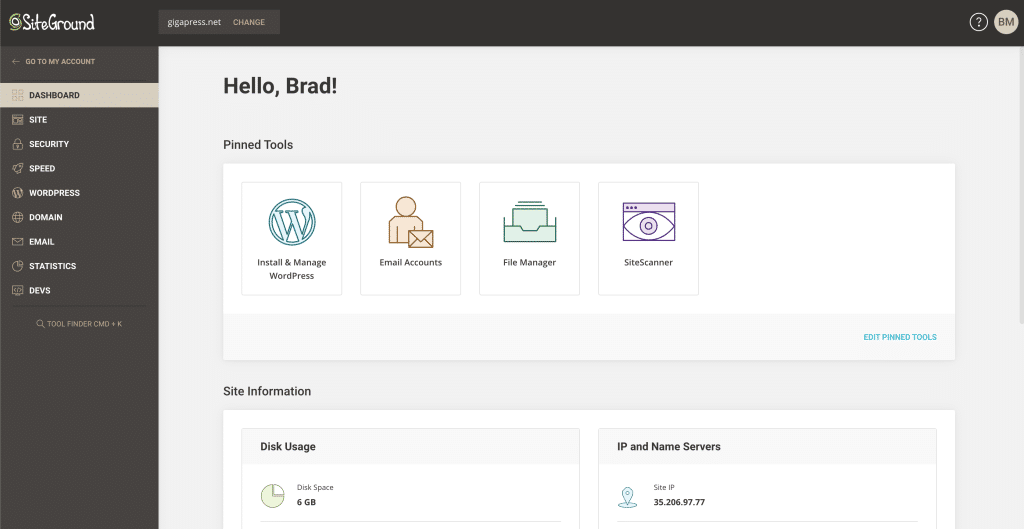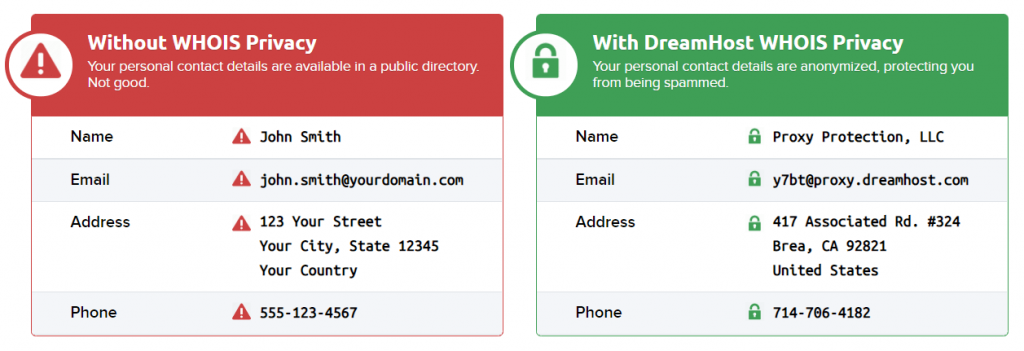Choosing the right web hosting service can be daunting, especially with so many options available. In this article, we compare three of the most popular web hosts: Bluehost, DreamHost, and SiteGround. We’ll dive into three key areas—performance, security, and pricing—to help you determine which service best fits your needs. Whether you’re starting a new website or looking to switch providers, understanding the strengths and weaknesses of Bluehost, DreamHost, and SiteGround will guide you in making an informed decision.
A solid web host is an integral part of your website. The good news is that there are several high-quality options available. However, this freedom of choice can be intimidating as you’re trying to find your perfect fit.
Fortunately, a little bit of knowledge can go a long way. By understanding the key differences in performance, security, support, and price, you can choose the best hosting provider for your needs.
Bluehost is a user-friendly host that enables you to scale up your website as it grows. In contrast, DreamHost is very beginner-friendly and has excellent value for money. Finally, SiteGround is a smaller alternative that offers higher-level security and performance features.
In this article, we’ll introduce you to Bluehost vs. DreamHost vs. SiteGround. Then, we’ll walk you through three important considerations to help you choose between them. Let’s go!
An Introduction to Bluehost vs. DreamHost vs. SiteGround
It’s no secret that choosing the right hosting provider is a big deal. Without the proper support, your site could be slow, and your visitors could suffer. As such, you might want to make this decision carefully.
Fortunately, WordPress can point you in the right direction with its official hosting recommendations: Bluehost, Dreamhost, and SiteGround. Let’s take a quick look at the basics of each provider.
First up is Bluehost:

Bluehost is a long-running hosting provider that’s been around for about 20 years. It’s largely known for its simplicity. Its multiple integrated tools also make it a popular all-in-one solution.
Next up is DreamHost:

In terms of open-source options, DreamHost is a powerhouse. It also offers convenient month-to-month pricing so that you can prioritize flexibility. Furthermore, DreamHost boasts some of the lowest prices around.
Last but not least, there’s SiteGround:

This provider is a smaller, fully independent company. The relatively limited customer base means that SiteGround can offer more comprehensive features and attentive service. It tends to appeal to small businesses but adapts well to nearly any type of customer.
All of these options offer exceptional value. However, there are also crucial differences between them. Understanding these distinctions can help you pick the right fit for your website.
Bluehost vs. DreamHost vs. SiteGround Compared (3 Key Points)
Let’s cover three areas where Bluehost, DreamHost, and SiteGround differ.
1. Performance and Features
Let’s start with a look at the main performance features of each service.
Bluehost
Bluehost offers several features to support your site. For example, you’ll have access to a staging environment to make safer site changes. You’ll also receive a free domain name.
Additionally, Bluehost offers an impressive drag-and-drop website builder. This tool features a straightforward interface with a large selection of AI-driven templates:

In many ways, this host could be a wise choice if you’re new to websites. Bluehost’s features make it easy to get started with WordPress. However, more advanced options such as centralized social media control and auto-scalability for large traffic volume mean you also have room to grow.
DreamHost
DreamHost offers an impressive 100 percent uptime guarantee. However, that’s not all it has to offer. In addition to perks such as a pre-installed version of the Jetpack plugin, you’ll also be able to use Dreamhost’s uniquely powerful control panel:

The intuitive layout means you can have more control over your site’s core functions. Nevertheless, you don’t have to be interested in back-end technology to enjoy DreamHost. You’ll also likely appreciate features such as free email hosting and automated migrations regardless of your skill level.
DreamHost offers all of these features for a relatively affordable price. It might not have all the functionality of its competitors. However, you’re still getting pretty high value for what you pay.
SiteGround
One of the more stand-out features of SiteGround is its Site Tools system. This feature stands in for cPanel. While it works similarly, Site Tools is generally more user-friendly thanks to cleaner and more organized navigation.

If you’re interested in the more technical aspects of hosting, you might also appreciate SiteGround’s development toolkit. Other agency-centric benefits include robust collaboration tools and client white-labeling.
Finally, the relatively small size of SiteGround (compared to the behemoth of Bluehost) means its shared hosting accounts inherently perform better. Fewer customers create less demand for resources. As such, even this basic hosting option can offer high performance.
2. Security
Keeping your site safe is probably a top priority. Here’s how each service performs in this area.
Bluehost
One of Bluehost’s most convenient features is its auto-backup system. There is no need to risk your data if you forget this part of your security routine – your host will take care of it for you. Similarly, Bluehost will also set you up with a free SSL certificate from the beginning.
In terms of more robust security, Bluehost uses a tiered system. You’ll get protection for different types of attacks. These include defenses such as firewalls and DDoS prevention.
Finally, Bluehost is also a proactive solution. It tries to work against both malware and spam before it ever reaches your site. Altogether, Bluehost is a smart security choice if you’re a hands-off user.
DreamHost
DreamHost takes a cutting-edge approach to its security with advanced features such as HTTP/2. As a technology that uses data encryption by default, it helps to protect your users’ personal information.
Additionally, it’s not just the users who can benefit. DreamHost also has ways to protect you as the site owner. One of our favorite security features is its domain privacy protection:

This security feature keeps your personal details off the web. Without the protection, your domain information is publicly available. Between this and other more standard options such as daily backups, DreamHost offers modern options to keep your site safe.
SiteGround
SiteGround protects its clients with a proactive, custom firewall. That feature means its defenses have been directly calibrated to serve its users best. It also receives frequent updates so that you’ll be safe from emerging threats:

Another stronger security feature is SiteGround’s anti-malware bot. This program interferes with any attacks aimed at your site. That way, you have multiple layers of support.
Moreover, SiteGround also offers a unique solution in its security pluginA plugin is a software component that adds specific features and functionality to your WordPress website. Esse... More. If you don’t want to constantly toggle settings on your host’s screen, this integrated plugin can give you access straight from the WordPress dashboardIn WordPress, the Dashboard is a central hub for managing a website's content and settings. It is the first sc... More.
3. Customer Support and Pricing
Finally, let’s look at how each provider can support the more administrative side of running a website.
Bluehost
All Bluehost plans come with 24/7 customer support. You can access it by chat or phone. If you’d rather solve issues on your own, Bluehost also provides a comprehensive knowledge base:

Bluehost’s WordPress-specific pricing plans begin at $2.95 per month. This impressively low price admittedly comes with more limited features. However, if you’re running a relatively small site, these restrictions shouldn’t pose any problems.
It also offers more advanced plans. The Pro option will cost you $13.95, for example, and is better suited for websites with higher traffic, such as e-commerce businesses.
DreamHost
DreamHost might be an intelligent choice if you’re looking for a dedicated WordPress support team. Its team is trained explicitly in WordPress issues to help meet your needs.
The support team is also in-house. This means you don’t have to worry about being outsourced to an unfamiliar company. You can access this support around the clock through email. A live chat function is also available if you want a quicker response:

In terms of cost, DreamHost is one of the cheaper options. Its WordPress-specific pricing starts at just $1.99 per month for a very basic package. Other plans come with larger price tagsIn WordPress, tags are a taxonomy used to classify and organize posts. They are similar to categories, but unl... More and more features, so there’s room to scale up if your needs change.
SiteGround
SiteGround boasts impressively quick response times for its customer service. You can access it through a 24/7 help center. Just like with DreamHost, you’ll be able to talk with WordPress experts who can help you out:

SiteGround tends to appeal to fewer users who want more features. Even so, the plans start at the affordable rate of $3.99 for the lowest-tier WordPress-specific option.
The most likely reason you’d want to scale to a more advanced plan is if your traffic needs change. The most significant difference between options is the monthly visits: the beginner plan accommodates 10,000, while the highest-tier package can handle 400,000.
Do You Still Have Any Questions About Choosing Between Bluehost, DreamHost and SiteGround For Your Website(s)?
Making the right choice between SiteGround, DreamHost, and Bluehost is crucial for the success of your website(s). If you still find yourself with questions lingering in your mind, you’re in the right place. we’re here to simplify things for you.
Let’s break it down:
- SiteGround: Known for its stellar customer support and blazing-fast loading times, SiteGround is an excellent choice for those who prioritize performance and reliability. With top-notch security features and easy scalability, it’s perfect for businesses of all sizes.
- DreamHost: DreamHost stands out for its affordability and user-friendly interface. If you’re on a tight budget and need a hosting provider that’s easy to navigate, DreamHost could be the one for you. Plus, it offers a range of features tailored to both beginners and experienced users alike.
- Bluehost: As one of the most popular hosting providers out there, Bluehost is favored for its reliability and robust features. From beginner-friendly tools to advanced options for developers, Bluehost caters to a wide range of users. Plus, its seamless WordPress integration makes it a go-to choice for WordPress enthusiasts.
Ultimately, the best choice depends on your specific needs and preferences. Consider factors such as pricing, performance, customer support, and scalability before making your decision. And remember, whichever provider you choose, you’re in good hands with SiteGround, DreamHost, or Bluehost.
Let’s address some common queries to help you make an informed decision.
- Performance: Are you concerned about the speed and reliability of your website? Each hosting provider has its strengths in terms of performance. SiteGround is renowned for its fast loading times and excellent uptime, ensuring your visitors have a seamless browsing experience. DreamHost offers reliable performance with its optimized servers, while Bluehost provides solid speed and uptime backed by robust infrastructure.
- Features: Are you wondering about the features offered by each hosting provider? SiteGround stands out with its user-friendly interface, free SSL certificates, daily backups, and built-in caching. DreamHost impresses with unlimited bandwidth, SSD storage, and a free domain name for the first year. Bluehost offers a user-friendly platform with one-click WordPress installation, free domain registration, and 24/7 support.
- Support: Do you prioritize excellent customer support? SiteGround offers top-notch support with its knowledgeable and responsive team available 24/7 via live chat, phone, and tickets. DreamHost provides extensive online resources and email support, while Bluehost offers 24/7 support through live chat, phone, and a robust knowledge base.
Remember, the best choice for your website(s) depends on your specific needs and preferences. Take your time to evaluate the performance, features, and support offered by SiteGro
Conclusion
Picking the right hosting is an essential first step toward running a high-quality website. With so many options available, it’s normal to feel intimidated. Fortunately, understanding how the top hosts perform can help you decide.
In this article, we compared Bluehost vs. DreamHost vs. SiteGround:
- Bluehost: A user-friendly option that provides plenty of room to grow.
- DreamHost: An affordable and beginner-friendly host.
- SiteGround: An independent hosting option that boasts multiple performance and security features.
Do you have any questions about Bluehost vs. DreamHost vs. SiteGround? Let us know in the commentsComments are a feature of WordPress that allow users to engage in discussions about the content of a website. ... More section below!



